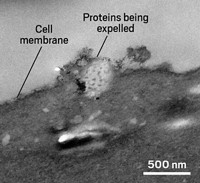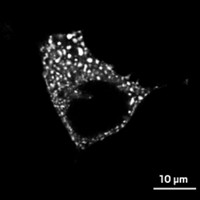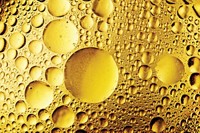Advertisement
Grab your lab coat. Let's get started
Welcome!
Welcome!
Create an account below to get 6 C&EN articles per month, receive newsletters and more - all free.
It seems this is your first time logging in online. Please enter the following information to continue.
As an ACS member you automatically get access to this site. All we need is few more details to create your reading experience.
Not you? Sign in with a different account.
Not you? Sign in with a different account.
ERROR 1
ERROR 1
ERROR 2
ERROR 2
ERROR 2
ERROR 2
ERROR 2
Password and Confirm password must match.
If you have an ACS member number, please enter it here so we can link this account to your membership. (optional)
ERROR 2
ACS values your privacy. By submitting your information, you are gaining access to C&EN and subscribing to our weekly newsletter. We use the information you provide to make your reading experience better, and we will never sell your data to third party members.
Biochemistry
Transient droplets organize biochemical reactions inside cells
Called condensates, the droplets pull together proteins and RNA when and where they’re needed. Now, they’re on pharma’s radar
by Carrie Arnold, special to C&EN
July 13, 2020
| A version of this story appeared in
Volume 98, Issue 27

Clifford P. Brangwynne smashed the single-celled embryo between a microscope slide and a thin glass cover slip. Then he peered into the microscope to get a look at the cell, taken from a worm commonly studied in the lab, Caenorhabditis elegans. What he expected to see were small, solid balls, composed of RNA and protein, dotting the cell. But instead, what he saw looked more like the world’s smallest lava lamp.
Rather than drifting throughout the cell’s liquid innards like wooden balls bobbing around in a tank of water, over and over the globs appeared, merged, and separated before disappearing. Brangwynne, then a postdoctoral scholar in Anthony Hyman’s lab at Max Planck Institute of Molecular Cell Biology and Genetics (MPI-CBG), realized: this isn’t something that solids do. The so-called P granules, which scientists had assumed were solids, were actually behaving like liquids.
“All of a sudden, everything made sense,” Brangwynne says. Scientists had been trying to understand how cells organize the biochemical reactions going on inside, keeping them separate so they didn’t interfere. The tiny lava lamp he watched undulating under the microscope held an answer.
What Brangwynne had observed through the microscope was a phenomenon called liquid-liquid phase separation (LLPS). In LLPS, an otherwise heterogeneous, well-mixed liquid can separate into two distinct phases, just as a vinaigrette salad dressing will naturally separate into an oil layer and a vinegar layer in the bottle.
Polymer chemists had been studying the phenomenon since the 1940s, with an eye toward using it to control the structure of polymers. But while biochemists recognized that biopolymers like RNA shared many properties with their synthetic polymer counterparts, no one had yet taken the idea forward to show that LLPS might also occur in living systems, says biophysicist Michael Rosen at the University of Texas Southwestern Medical Center.
Around the same time that Brangwynne published his seminal discovery in Science in 2009 (DOI: 10.1126/science.1172046), Rosen spied another way LLPS was occurring in cells. He found that when a cell builds its structural support, or cytoskeleton, three of the proteins that help to build the scaffolding can transition from individual subunits to a large, complex polymer in the shape of a droplet.
Since then, scientists have found LLPS almost everywhere they look inside cells. Whereas cells normally contain defined compartments called organelles that are encapsulated by membranes, the condensates that transiently form during LLPS create membrane-less organelles. They bring together proteins, RNA, and other macromolecules to react when and where needed—an organizational system for cellular biochemistry.
Even more important, Brangwynne says, “these droplets are speeding up chemical reactions by concentrating the reactants in a small volume.”
As scientists have since found, the condensates can also slow down nearby reactions by sequestering certain molecules, removing them from circulation. LLPS is, in a sense, a chemical rheostat for cells, giving them the ability to finely tune an array of reactions in response to changing environmental conditions.
More recently, biochemists have focused their attention on what happens when good condensates go bad. Most of the work has focused on the role of LLPS in neurodegeneration and cancer, both of which have links to condensates that form and then solidify, rather than remaining liquid. The challenge for biochemists is to uncover more about how the condensates function in physiological systems rather than cellular models and to figure out how to target such dynamic and ephemeral structures with pharmaceuticals.
A condensed history
In 1899, Columbia University cell biologist Edmund Beecher Wilson delivered a lecture at the Marine Biological Laboratory titled “The Structure of Protoplasm.” Based on his studies of sea urchin eggs, Wilson argued that the inside of a cell, or cytoplasm, as researchers would rename it, “is a mixture of liquids in the form of a fine emulsion consisting of a continuous substance in which are suspended drops.” Despite Wilson’s stature as a paramount scientist, no one followed up on this claim.
In the 1940s, synthetic polymer chemists noticed that many of the monomers they were studying were multivalent, meaning they could simultaneously form multiple weak, noncovalent bonds with other molecules in solution. They could remain perfectly soluble in a solvent until they reached a saturation point, a particular concentration at which they would condense into droplets within the solution. The greater degree of multivalency in the monomers, the lower the concentration of monomers required to reach the saturation point.
For the next 60-plus years, industrial and polymer chemists alike would use this phenomenon to separate mixtures of polymers and to control polymer morphology. To Rosen, the behavior of these synthetic polymers had obvious parallels to biological polymers like proteins and nucleic acids. But biologists generally didn’t spend much time studying the processes of industrial chemistry, nor did these chemists know much about the molecular details of how cells function or why a process like LLPS might help facilitate biochemical reactions by bringing together components at high concentrations.

All that changed in the summer of 2008 when Brangwynne made his discoveries about P granules. Ironically enough, the discoveries were sparked while he was teaching a course with his lab director, Hyman, at the same Marine Biological Laboratory where Wilson gave his lecture 109 years before. During the class—on cellular physiology—two students noticed the lava lamp–like behavior of P granules in a recently fertilized C. elegans egg. When the visiting lecturers returned to MPI-CBG in Dresden, Germany, they began investigating the phenomenon more closely. The more Brangwynne dug into the topic, the more he realized that phase separation could explain why P granules could merge, separate, and seemingly flow throughout the cell. As a physicist, it wasn’t something Brangwynne had originally set out to do. But the properties of these biomolecular condensates were too intriguing for him to pass up.
“It was a discovery that came from being in the right place at the right time with the right background,” he says.
He and Hyman toiled in Dresden, eventually discovering that P granule droplets moved freely around the single-celled embryo—right up until the fertilized egg divided for the first time. During the division, the so-called polarity proteins PAR-1 and PAR-2 would concentrate on one side of the embryo, Brangwynne found, and P granules formed there when the proteins reached a high enough concentration. Then, the granules rapidly condensed on a single side of the cell into a solid-looking clump of proteins. As the embryo divided, the granules were confined to only one of the two resulting daughter cells. Their presence in that daughter cell steers the development of the embryo into distinct tissues and, ultimately, an adult worm.
The researchers’ breakthrough wasn’t just their identification of a mechanism that could guide roundworm development but rather that LLPS represented a useful strategy for all sorts of biochemical cellular processes. These discoveries “took Cliff looking at the soft matter of life through a new lens—literally, a new lens,” says Amy Gladfelter, a quantitative cell biologist who studies the role of phase separation in biology at the University of North Carolina at Chapel Hill.
That same year, 8,487 km away from Dresden in Dallas, Rosen had the same realization about LLPS being a useful strategy. Rosen, however, was studying the cell’s cytoskeleton, or structural scaffold. His team found that three proteins formed liquid droplets as they built the cytoskeleton. Rosen then engineered proteins with various repeated binding units to measure how a protein’s ability to bind multiple partners affected its ability to phase separate. He found that proteins with more repeats, and therefore a higher valency, formed condensates at lower concentrations—drawing an explicit parallel to the phase separation trends seen for 70 years by polymer chemists. Rosen’s findings pointed to a protein’s multivalency playing a major role in LLPS.
He knew the results were significant, but there was one major problem: the top-tier journals he believed were ideal for publishing his results refused to accept his manuscript. After several years and four rounds of revisions at Nature, the fifth reviewer continued to balk. Rosen’s point was too obvious, the reviewer said. It seemed readily apparent that synthetic polymers would show similar behaviors to proteins. But that was exactly the point, Rosen said. No one else in biology had shown that, he argued, and the field needed to start thinking that way. In 2012, after more than 4 years of wrangling, Rosen won, and his paper was published (Nature, DOI: 10.1038/nature10879).
It wasn’t long before biologists began finding LLPS everywhere they looked. The nucleolus, a dense structure inside a cell’s nucleus where ribosomes are made, was a condensate. So was the cluster of proteins that formed to transcribe DNA into RNA. They function akin to cellular organelles in that the droplets bring together the appropriate molecules to facilitate chemical reactions, says Tanja Mittag, a structural biologist at St. Jude Children’s Research Hospital. Reactants at high concentrations within the condensates will make reactions faster than if the molecules were left to randomly encounter each other in the cell’s dilute cytoplasm.
What intrigued scientists about the condensates, beyond their membrane-less existence, was that they could form spontaneously in response to cellular conditions. Small changes in concentration can trigger the droplets to form, almost as if a switch has been flicked, Mittag says.
What no one could explain, however, was the physical and chemical processes that drove formation, and why, in certain diseases, the condensates formed and then solidified.

Disorder makes order
As scientists discovered more examples of LLPS in cells, they began to identify commonalities across many of the proteins that underwent phase separation. As Rosen had discovered, multivalency was key, but researchers eventually identified one specific type of protein motif that was especially suited to both multivalency and LLPS.
A protein’s overall, three-dimensional shape arises in part from structured regions called α-helixes and β-sheets. Among these regions are nooks and crannies that don’t take on any secondary structure at all. They’re “loose and floppy,” according to Dora Tang, a synthetic biologist at MPI-CBG. More technically, these unstructured regions are called low-complexity domains. And they are the motifs found commonly in the condensates formed during LLPS. In particular, researchers discovered RNA-binding proteins have low-complexity domains that make them especially prone to LLPS.
Benjamin Wolozin, a pharmacologist at Boston University, has spent the past decade diving more deeply into the molecular interactions in low-complexity domains, including those that facilitate LLPS. He found that amino acid residues in these low-complexity domains participate in weak interactions, such as salt bridges, π stacking, and cation-π interactions, in which a dipolar residue like arginine associates with an aromatic residue like tyrosine. All these interactions create weak bonds in the so-called Goldilocks zone: where the attractive forces are strong enough to pull two parts of a protein together but weak enough that they can break with relative ease. These noncovalent interactions are the molecular equivalent of a sticky note, which can readily stick and unstick. The transitory bonds allow the macromolecules to coalesce into a liquid, rather than a solid.
LLPS in cells can seem miraculous, Wolozin says. “It provides this amazing way that many different types of protein processes can organize themselves through simple biophysics.”
The neurodegenerative disease amyotrophic lateral sclerosis (ALS, also known as Lou Gehrig’s disease), has been a focal point for understanding LLPS. In ALS, motor neurons degenerate and die, causing people to lose their ability to walk, talk, and eventually, breathe. Scientists have found that in the motor neurons of ALS patients, stress granules form but they don’t dissolve. These granules are a type of condensate that arises when cells are stressed by heat, chemicals, and other environmental factors. But usually, stress granules are transient, disappearing along with the stressor.
In 2010, scientists including Wolozin showed that the RNA-binding protein TDP-43 is a key component of stress granules (PLOS One, DOI: 10.1371/journal.pone.0013250). Mutations to this protein, a feature of ALS, make it too sticky. Instead of a sticky note, the mutated TDP-43 protein acts like duct tape, and liquid droplets solidify into solid aggregates.
Advertisement
A decade of work has revealed that abnormalities in LLPS play a key role in the development of ALS, and scientists believe that targeting LLPS may help slow the progression of not only ALS but also other neurodegenerative diseases and even cancer as scientists have linked all these conditions to abnormal condensate formation. It’s why the pharmaceutical industry—including giants like Merck & Co. as well as small start-ups like Dewpoint Therapeutics and Aquinnah Pharmaceuticals—has developed a major interest in condensates over the last several years. The challenge, says Jason Imbriglio, director of chemical biology at Merck, is to develop the tools to study condensates in real time in cells to identify molecules that can modulate their formation and dissolution. Dewpoint’s chief scientific officer, Mark Murcko, says that, whether scientists are studying condensates or targeting them therapeutically, working with the structures requires a whole different mindset.
“We tend to think of molecules randomly wandering around in the cytoplasm. But condensates drive specific subsets of molecules together in specific conditions,” Murcko says.
Not only will it be crucial for anyone in pharma to understand LLPS because condensates themselves are potential drug targets, it will also be crucial because phase separation may play a role in how drugs function inside cells. A recent Science paper showed that the cancer drug cisplatin doesn’t diffuse evenly throughout cells but rather concentrates in distinct spots, thanks to the process of phase separation (2020, DOI: 10.1126/science.aaz4427). Far from being an anomaly, Brangwynne says, this work shows that LLPS plays a fundamental role in cellular chemical reactions.
Carrie Arnold is a freelance science writer based in Richmond, Virginia.
CORRECTION
This story was updated on July 15, 2020, to correct Michael Rosen's location. He is in Dallas, not San Antonio.





Join the conversation
Contact the reporter
Submit a Letter to the Editor for publication
Engage with us on Twitter